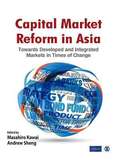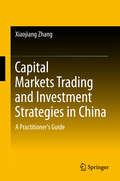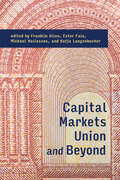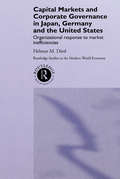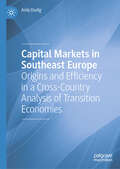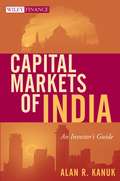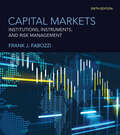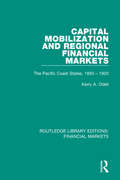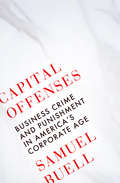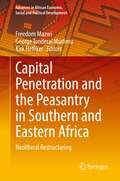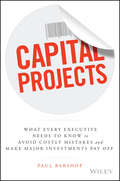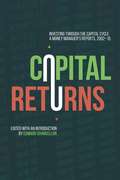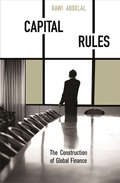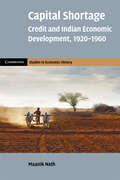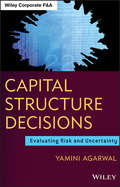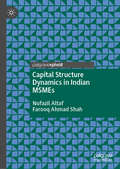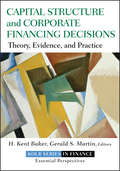- Table View
- List View
Capital Inflows and the Real Exchange Rate: Can Financial Development Cure the Dutch Disease?
by Christian SaborowskiA report from the International Monetary Fund.
Capital Inflows: Macroeconomic Implications and Policy Responses
by M. Ayhan Kose Roberto Cardarelli Selim ElekdagA report from the International Monetary Fund.
Capital Market Reform in Asia
by Masahiro Kawai Andrew ShengCapital Market Reform in Asia is a compilation of selected papers that captures the essence of the issues and challenges that contributed to capital market reform in the Asian region. The central theme of this volume is to chart the progress of capital market development in Asia after the 1997-1998 Asian financial crisis, to understand the complex process of capital market deepening in emerging market economies, and to acknowledge that in the aftermath of the global financial crisis of 2007-2009, robust Asian capital markets are crucial for mobilizing domestic savings for investments in Asia, both nationally and regionally. The book provides new insights into several important themes in capital market reforms in asia and is written by Asian financial policymakers, practitioners, scholars and experts invited by the organisation for Economic Co-operation and Development (OECD) and the Asian Development Bank Institute (ADBI).
Capital Markets Trading and Investment Strategies in China: A Practitioner's Guide
by Xiaojiang ZhangThis book covers in detail the building blocks of Chinese capital markets at the financial instrument level, the analytical pricing term structure of those instruments, the macro and industry economic framework and progress of the liberalization processes at work in the respective markets, the interaction of various participants in the markets, their trading and investment objectives and rationales, some of the most frequently applied trading and investment strategies, and risk management techniques. The book will especially benefit financial practitioners with in-depth knowledge of their respective capital markets area regarding foreign exchange, money markets, fixed income, and related derivatives, and who have a keen interest in gaining deeper insights into the Chinese market so as to develop or strengthen their global strategy application and risk management practice.
Capital Markets Union and Beyond (The\mit Press Ser.)
by Ester Faia Michael Haliassos Katja Langenbucher Franklin AllenExperts from economics, finance, law, policy, and banking discuss the design and implementation of a future capital market union in Europe.The plan for further development of Europe's economic and monetary union foresees the creation of a capital market union (CMU)—a single market for capital in the entire Eurozone. The need for citizens and firms of all European countries to have access to funding, together with the pressure to improve the efficiency and risk-sharing opportunities of the financial system in general, put the CMU among the top priorities on the Eurozone's agenda. In this volume, leading academics in economics, finance, and law, along with policy makers and practitioners, discuss the design and implementation of a future CMU.Contributors describe the key design challenges of the CMU; specific opportunities and obstacles for reaching the CMU's goals of increasing the economic well-being of households and the profitability and viability of firms; the role that markets—from the latest fintech developments to traditional equity markets—can play in the future success of CMU; and the institutional framework needed for CMU in the aftermath of the global recession.ContributorsSumit Agarwal, Franklin Allen, Valentina Allotti, Gene Amromin, John Armour, Geert Bekaert, Itzhak Ben-David, Marcello Bianchi, Lorenzo Bini-Smaghi, Claudio Borio, Franziska Bremus, Marina Brogi, Claudia M. Buch, Giacomo Calzolari, Souphala Chomsisengphet, Luca Enriques, Douglas D. Evanoff, Ester Faia, Eilis Ferran, Jeffrey N. Gordon, Michael Haliassos, Campbell R. Harvey, Kathryn Judge, Suzanne Kalss, Valentina Lagasio, Katya Langenbucher, Christian T. Lundblad, Massimo Marchesi, Alexander Michaelides, Stefano Micossi, Emanuel Moench, Mario Nava, Giorgio Barba Navaretti, Giovanna Nicodano, Gianmarco Ottaviano, Marco Pagano, Monica Paiella, Lubos Pastor, Alain Pietrancosta, Richard Portes, Alberto Franco Pozzolo, Stephan Siegel, Wolfe-Georg Ringe, Diego Valiante
Capital Markets and Corporate Governance in Japan, Germany and the United States: Organizational Response to Market Inefficiencies
by Helmut DietlWhy did financial keiretsu develop in Japan, but not in Germany and the United States? Why is bank intermediation more dominant in Germany and Japan than in the United States? What are the advantages and disadvantages of each system? Capital Markets and Corporate Governance in Japan, Germany and the United States answers these and related questions
Capital Markets and Financial Intermediation in The Baltics
by Alfred Schipke Niamh Sheridan Susan Mary GeorgeA report from the International Monetary Fund.
Capital Markets in Southeast Europe: Origins and Efficiency in a Cross-Country Analysis of Transition Economies
by Ante DodigThis book considers the theme of capital markets prowess and its link with surrounding economic dexterity. It presents the story on the back of dual intertwined cornerstone pillars: The initial agenda sets the global macroeconomic context and its interplay with financial markets and sub-segment capital markets. Then the book moves to the evolvement of the inherent capital markets, from nascence to present day, and through profiling of the current operating surroundings. The latter pillar performs empirical research built upon Eugene Fama’s weak form efficiency theorem with statistical testing results further framing the comprehensive findings on five selected southeast European developing capital markets. Jointly the two parts present the first such well-documented capital markets set up complemented by wide-ranging empirical findings of inefficiency. The book introduces at first the global perspective, in which the growing globalization in the past decades has led to improved efficiencies, to faster innovation, and to greater systemic connectedness and meaningfully so by an increasing contribution from transitioning economies. Nevertheless, in higher systemic concentration there is an implied higher volatility risk and evidence has revealed dichotomous reaction through divergence in impact between the developed and the developing economies. The capital markets industry is at the forefront of financial innovation and many aspects in its function and power are a determining factor in wider socio-economic progress. The findings uncover details of market structure and role and with that this work creates significant new knowledge on the industry, and will be of particular interest to investors, taxpayers, academics, researchers, and policy makers of capital markets.
Capital Markets of India
by Alan R. KanukCapital Markets in India: An Investor's Guide aims to provide the first comprehensive book on investing in the India markets. India is right now at the forefront of globalization. The book's focus is on the equity market, but it also addresses derivatives, fixed income, and foreign direct investments. Chapter topics include facts about the Indian economy; the Foreign Institutional Investor (FII) regulations, registration process, and applications; detail about the market regulation and the regulator; the very important market safeguards built into the Indian market systems; and lists of companies ranked by various criteria such as capitalization, turnover, industry, and earnings. The book even supplies investors and traders with contact information for many of the key institutions and market players. Readers will not only gain basic information about how the markets in India work, but also the contacts and facts to help them with their own investing plan.
Capital Markets, sixth edition: Institutions, Instruments, and Risk Management
by Frank J. FabozziThe comprehensively updated sixth edition of a leading textbook that examines the wide range of instruments available in financial markets, with new material on central banks, capital market technology, and financing markets for small businesses.Capital markets are an integral part of the financial system, and their evolution reflects a larger story of global financial change characterized by shifts in regulations, investor behavior, and technological advancements. Now in a comprehensively updated new edition, this widely used textbook examines the wide range of instruments for financing, investing, and controlling risk in today’s financial markets. The book begins with an introduction to financial markets, followed by a detailed examination of risk, including financial risk identification, quantification, and management. It then covers market participants, including a new chapter on central banks; fundraising markets, with a new chapter on financing markets for small businesses; risk and return theories; equity, debt, and derivatives markets; and capital market technologies, in a dedicated new section. Sixth edition highlights: • Includes new chapters on central banks, capital market technologies, and financing markets for small businesses• Incorporates analysis of the role of technological innovation throughout• Offers broad coverage of all types of financial instruments, including cash and derivative instruments, as well as the risk management dilemmas confronted by major institutional investors • Features rich pedagogy and resources, including end-of-chapter discussion questions and integrated online appendices
Capital Mobilization and Regional Financial Markets: The Pacific Coast States, 1850-1920 (Routledge Library Editions: Financial Markets #12)
by Kerry OdellOriginally published in 1992, Capital Mobilization and Regional Financial Markets, argues that barriers to financial flows within regions may be as important in affecting capital flows as interregional barriers. The book conjectures that regional markets allow efficient mobilization of local funds and develops an analytical framework to motivate an investigation of region financial development in the Pacific Coast states between 1850 and 1920.
Capital Offenses: Business Crime and Punishment in America's Corporate Age
by Samuel W. BuellFrom the lead prosecutor on the Enron investigation, an eye-opening examination of the explosion of American white-collar crime. If “corporations are people too,” why isn’t anyone in jail? A serious defect in a GM car causes accidents; Enron scams investors out of their money; banks bet on the housing market crash and win. In the race to maximize profits, corporations can behave in ways that are morally outrageous but technically legal. In Capital Offenses, Samuel Buell draws on the unique pairing of his expertise as a Duke University law professor and his personal experience leading the investigation into Enron—the biggest white-collar crime case in U.S. history—to present an in-depth examination of business crime today At the heart of it sits the limited liability corporation, simultaneously the bedrock of American prosperity and the reason that white-collar crime is difficult to prosecute—a brilliant legal innovation that, in its modern form, can seem impossible to regulate or even manage. By shielding employees from legal responsibility, the corporation encourages the risk-taking that drives economic growth. But its special legal status and its ever-expanding scale place daunting barriers in the way of federal and local investigators. Detailing the complex legal frameworks that govern both corporations and the people who carry out their missions, Buell shows that deciphering business crime is rarely black or white. In lucid, thought-provoking prose, he illuminates the depths of the legal issues at stake—delving into fraudulent practices like Ponzi schemes, bad accounting, insider trading, and the art of “loopholing”—showing how every major case and each problem of law further exposes the ambivalence and instability at the core of America’s relationship with its corporations. An expert in criminal law, Buell masterfully examines the limits of too permissive or overzealous prosecution of business crimes. Capital Offenses invites us to take a fresh look at our legal framework and learn how it can be used to effectively discipline corporations for wrongdoing, without dismantling the corporation.
Capital One Financial Corp.
by Bharat N. Anand Michael G. Rukstad Christopher H. PaigeDesigned to explore the structure, implementation, and sustainability of an information-based strategy (IBS) undertaken by Capital One during the 1990s. Particular issues of interest are the impact of mass customization on industry structure, the ability to transfer IBS skills to new sectors, and the impact of the Internet on industry structure and competitor strategies.
Capital Penetration and the Peasantry in Southern and Eastern Africa: Neoliberal Restructuring (Advances in African Economic, Social and Political Development)
by Kirk Helliker Freedom Mazwi George Tonderai MudimuThis book examines the impact of neoliberalism on peasant agriculture as a key livelihood strategy in Southern and Eastern Africa, against the background of the current development crisis and the crossroads that Southern and Eastern Africa faces. It systematically analyses how the neoliberal architecture has deepened extroverted production for capitalist accumulation and how this has been to the detriment of the rural labour force and small scale and communal landowners. Apart from examining how neoliberalism has triggered land alienations, the book further argues that such policies have also impacted negatively on food security in a number of ways. The book presents empirical evidence through twelve case studies, emerging from in-depth original fieldwork carried out in seven countries in the Southern and Eastern African region. This book is a must-read for scholars of economics,sociology, anthropology, history, agrarian studies and political science, as well as practitioners and policy-makers, interested in a better understanding of the impact of the agrarian neoliberal restructuring on the peasantry in Southern Africa.
Capital Projects as Real Options: An Introduction
by Timothy A. LuehrmanIntroduces a framework for evaluating corporate investment projects as call options. Presumes readers are familiar with basic option pricing and basic capital budgeting rules. Explains the motivation for viewing projects as options; presents a mapping between a capital project and an option; shows how to price the option; and explores the managerial implications of this approach to capital budgeting. Concludes with a discussion of common practical, analytical questions that arise with this methodology.
Capital Projects: What Every Executive Needs to Know to Avoid Costly Mistakes and Make Major Investments Pay Off
by Paul BarshopA real-world framework for driving capital project success Capital Projects provides an empirically-based framework for capital project strategy and implementation, based on the histories of over 20,000 capital projects ranging from $50,000 to $40 billion. Derived from the detailed, carefully normalized database at preeminent project consultancy IPA, this solid framework is applicable to all types of capital investment projects large and small, in any sector, including technology, life sciences, petroleum, consumer products, and more. Although grounded in empirical research and rigorous data analysis, this book is not an academic discussion or a conceptual dissertation; it's a practical, actionable, on-the-ground guide to making your project succeed. Clear discussion tackles the challenges that cause capital projects to fail or underperform, and lays out exactly what it takes to successfully manage a project using real-world methods that apply at any level. Businesses report that 60 percent of their projects fail to meet all business objectives, and IPA's database shows that projects' final average net present value undershoots initial estimates by 28 percent. This book provides concrete, actionable solutions to help you avoid the pitfalls and lead the way toward a more positive outcome. Avoid the missteps that make capital projects fail Learn the specific practices that drive project success Understand what effective capital project management entails Discover real-world best practices that generate more value from capital When capital projects fail, it is almost always preventable. Inefficiency, underestimated timelines, and unforeseen costs are the primary weights that drag a project down—and they are all avoidable with good management. Capital Projects gives you the insight and practical tools you need to drive a successful project.
Capital Requirements, Disclosure, And Supervision In The European Insurance Industry
by Maria Grazia Starita Irma MalafronteCapital Requirements, Disclosure, and Supervision in the European Insurance Industry provides an in-depth analysis of Solvency II's issues by combining both a theoretical approach and evidence of the empirical implications and effects on the European insurance industry.
Capital Returns: Investing Through The Capital Cycle: A Money Manager's Reports 2002-15
by Edward ChancellorWe live in an age of serial asset bubbles and spectacular busts. Economists, policymakers, central bankers and most people in the financial world have been blindsided by these busts, while investors have lost trillions. Economists argue that bubbles can only be spotted after they burst and that market moves are unpredictable. Yet Marathon Asset Management, a London-based investment firm managing over $50 billion of assets has developed a relatively simple method for identifying and potentially avoiding them: follow the money, or rather the trail of investment. Bubbles whether they affect a whole economy or merely a single industry, tend to attract a splurge of capital spending. Excessive investment drives down returns and leads inexorably to a bust. This was the case with both the technology bubble at the turn of the century and the US housing bubble which followed shortly after.
Capital Rules: The Construction of Global Finance
by Rawi Abdelal"The rise of global financial markets in the last decades of the twentieth century was premised on one fundamental idea: that capital ought to flow across country borders with minimal restriction and regulation. Freedom for capital movements became the new orthodoxy. In an intellectual, legal, and political history of financial globalization, Rawi Abdelal shows that this was not always the case. Transactions routinely executed by bankers, managers, and investors during the 1990s—trading foreign stocks and bonds, borrowing in foreign currencies—had been illegal in many countries only decades, and sometimes just a year or two, earlier. How and why did the world shift from an orthodoxy of free capital movements in 1914 to an orthodoxy of capital controls in 1944 and then back again by 1994? How have such standards of appropriate behavior been codified and transmitted internationally? Contrary to conventional accounts, Abdelal argues that neither the U.S. Treasury nor Wall Street bankers have preferred or promoted multilateral, liberal rules for global finance. Instead, European policy makers conceived and promoted the liberal rules that compose the international financial architecture. Whereas U.S. policy makers have tended to embrace unilateral, ad hoc globalization, French and European policy makers have promoted a rule-based, “managed” globalization. This contest over the character of globalization continues today."
Capital Rules: The Construction of Global Finance
by Rawi Abdelal"The rise of global financial markets in the last decades of the twentieth century was premised on one fundamental idea: that capital ought to flow across country borders with minimal restriction and regulation. Freedom for capital movements became the new orthodoxy. In an intellectual, legal, and political history of financial globalization, Rawi Abdelal shows that this was not always the case. Transactions routinely executed by bankers, managers, and investors during the 1990s—trading foreign stocks and bonds, borrowing in foreign currencies—had been illegal in many countries only decades, and sometimes just a year or two, earlier. How and why did the world shift from an orthodoxy of free capital movements in 1914 to an orthodoxy of capital controls in 1944 and then back again by 1994? How have such standards of appropriate behavior been codified and transmitted internationally? Contrary to conventional accounts, Abdelal argues that neither the U.S. Treasury nor Wall Street bankers have preferred or promoted multilateral, liberal rules for global finance. Instead, European policy makers conceived and promoted the liberal rules that compose the international financial architecture. Whereas U.S. policy makers have tended to embrace unilateral, ad hoc globalization, French and European policy makers have promoted a rule-based, “managed” globalization. This contest over the character of globalization continues today."
Capital Shortage: Credit and Indian Economic Development, 1920–1960 (Cambridge Studies in Economic History - Second Series)
by Maanik NathThe great majority of the population in colonial and postcolonial India lived in the countryside and were poor. Many were unable to find gainful work outside agriculture and remained dependent on a livelihood that provided only subsistence, and a precarious one. Seeking the roots of persistent poverty, Maanik Nath finds that the pervasive high cost and shortage of capital affected the peasant's ability to invest in land. The productivity of land, as a result, remained small and changed little. Bridging economic theory and historical evidence, Capital Shortage shows that climate, law, policy design, and interactions between these factors, perpetuated a stubborn cycle of low investment and widespread deprivation over several decades. These findings can be tested against credit and development in preceding and succeeding periods as well as positioned in comparative global context.
Capital Structure Decision: Underlying Theory
by William E. FruhanDemonstrates hypothetically and numerically the share price valuation impact of changes in a firm's capital structure.
Capital Structure Decisions
by Yamini AgarwalInside the risk management and corporate governance issues behind capital structure decisionsPractical ways of determining capital structures have always been mysterious and riddled with risks and uncertainties. Dynamic paradigm shifts and the multi-dimensional operations of firms further complicate the situation. Financial leaders are under constant pressure to outdo their competitors, but how to do so is not always clear. Capital Structure Decisions offers an introduction to corporate finance, and provides valuable insights into the decision-making processes that face the CEOs and CFOs of organizations in dynamic multi-objective environments.Exploring the various models and techniques used to understand the capital structure of an organization, as well as the products and means available for financing these structures, the book covers how to develop a goal programming model to enable organization leaders to make better capital structure decisions. Incorporating international case studies to explain various financial models and to illustrate ways that capital structure choices determine their success, Capital Structure Decisions looks at existing models and the development of a new goal-programming model for capital structures that is capable of handling multiple objectives, with an emphasis throughout on mitigating risk.Helps financial leaders understand corporate finance and the decision-making processes involved in understanding and developing capital structureIncludes case studies from around the world that explain key financial modelsEmphasizes ways to minimize risk when it comes to working with capital structuresThere are a number of criteria that financial leaders need to consider before making any major capital investment decision. Capital Structure Decisions analyzes the various risk management and corporate governance issues to be considered by any diligent CEO/CFO before approving a project.
Capital Structure Dynamics in Indian MSMEs
by Nufazil Altaf Farooq Ahmad ShahThis book examines the capital structure dynamics in Indian MSMEs, offering empirical evidence to better understand the financial practices within entrepreneurial settings. Altaf and Shah in this book assess the financing pattern of Indian MSMEs, response of capital structure determinants to different macroeconomic states, links between working capital and capital structure, cash flow volatility and capital structure and also the impact of credit risk on capital structure and firm performance relationship. This book enthuses the audience looking to understand newer dynamics of capital structure and its interplay in the Indian MSMEs.
Capital Structure and Corporate Financing Decisions
by H. Kent Baker Gerald S. MartinA comprehensive guide to making better capital structure and corporate financing decisions in today's dynamic business environmentGiven the dramatic changes that have recently occurred in the economy, the topic of capital structure and corporate financing decisions is critically important. The fact is that firms need to constantly revisit their portfolio of debt, equity, and hybrid securities to finance assets, operations, and future growth.Capital Structure and Corporate Financing Decisions provides an in-depth examination of critical capital structure topics, including discussions of basic capital structure components, key theories and practices, and practical application in an increasingly complex corporate world. Throughout, the book emphasizes how a sound capital structure simultaneously minimizes the firm's cost of capital and maximizes the value to shareholders.Offers a strategic focus that allows you to understand how financing decisions relates to a firm's overall corporate policyConsists of contributed chapters from both academics and experienced professionals, offering a variety of perspectives and a rich interplay of ideasContains information from survey research describing actual financial practices of firmsThis valuable resource takes a practical approach to capital structure by discussing why various theories make sense and how firms use them to solve problems and create wealth. In the wake of the recent financial crisis, the insights found here are essential to excelling in today's volatile business environment.

